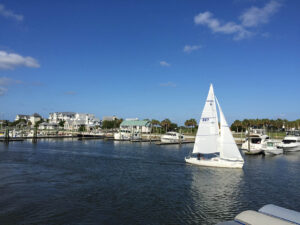Long Island Sound offers a world of opportunities for local and vacationing anglers alike during the summer season. Whether you’re a local resident, weekend warrior or vacation visitor, from New Rochelle to Montauk, Long Island Sound offers a diverse angling landscape where a variety of inshore species inhabit the area during the summer season. The plethora of bays including Huntington Bay, Oyster Bay, Smithtown Bay in the Western Sound as well as Great Peconic Bay, Little Peconic Bay and Gardiners Bay to the east and the many inlets, creeks and shallow water estuaries which dot the coastline are a magnet for northeast saltwater favorites including striped bass, summer flounder and bluefish. Here, light-tackle reigns supreme and non-stop action can make for an exciting day on the water. An abundance of angler-friendly marinas and launch ramps provide daily access or slips for extended stays for visiting anglers.
For non-stop rod-bending action, bluefish provide thrills for anglers, especially kids, and are abundant all over the Sound during the summer. While they are easily caught trolling wireline with a variety of plugs, spoons and umbrella rigs, this heavytackle technique provides little sport. A better approach is a six-pound spinning or baitcasting outfit which allows casting surface plugs such as a four-inch Tsunami Ported Popper or Guides Secret Baby Bottle Popper. Effective color combinations include blue/silver and black/silver, solid while and solid chartreuse. Be on the water at daybreak on an incoming tide and focus on shallow water flats, channel edges and bridges where bluefish prowl seeking an easy meal. Utilize a moderate retrieve while occasionally snapping the plug on the surface which creates a commotion bluefish can’t resist. Often multiple choppers can be seen crashing the plug on the surface and expect several to follow their hooked relative right to the boat. As the sun rises higher in the sky casting small metals, such as a Kastmaster, Krocodile or Hopkins, will draw strikes as these lures sink lower in the water column where bluefish lurk in the bright daylight. When using plugs remove the forward set of treble hooks and crush the barb on all hooks to expedite a quick release while also avoiding injury to the fish and angler.
Striped bass are also plentiful in Long Island Sound though tactics change during the summer months as the water tempera-umbrella rigs, bunker spoons and plugs will produce through June before livelining and chunking with bunker becomes the better approach. When chunking, anchor up ahead of a channel edge and cut bunker into chunks and dispense overboard at regular intervals to draw bass to the boat. Use a bunker chunk on a fishfinder rig with a circle hook to match the size chunks you’re dispersing and add an appropriate size sinker to place your offering at the bottom. Leave the reel in free spool and apply light thumb pressure to prevent line from leaving the spool. When a bass picks up the bait engage the reel and allow the bass to hook itself with the circle hook.
For a light-tackle approach, casting bucktails and small swim baits such as the Tsunami Swim Shads or leadhead jigs with rubber tails including DOA C.A.L Shad Tails or Jerk Baits is tough to beat. Keep in mind unlike bluefish, striped bass are not aggressive feeders and require a slightly different approach. Target areas such as channel edges, bridge supports, dock pilings and sod banks. Look for the best action to occur during the incoming tide of early morning and in the evening. When focusing your efforts around bridges and pilings, cast near the structure and allow the artificial to sink to the bottom before beginning a slow, deliberate retrieve. Remember a high-speed reel will require an even slower turn of the handle to make an effective presentation.
Without question, summer flounder, or fluke as they are often referred to, are the most popular species in the Sound and will respond to a variety of rigs, baits and artificial offerings. The most popular natural baits are squid strips with spearing or a live killie added. Most bottom structure will hold these flatfish though channel edges, deep holes and rocky bottom contour will produce the larger species. When using natural bait a three-way swivel with a Kahle hook of 2/0-4/0 size snelled to a 24-inch 30- pound test leader is a good choice. Add enough weight to hold bottom with an eightinch length of monofilament attached to the third loop in the swivel and a loop to change weights as desired. Cut squid in long strips and hook at tail end and add a live killie hooked through the tail to allow it to frantically swim. Drop offering to bottom and leave reel in free-spool to drop back a few feet when a bite occurs.
Though natural baits are effective, bucktails can be downright deadly on fluke and will often produce larger specimens. White, pink and chartreuse versions are preferred and weight required will be determined by water depth and current. A teaser rig with a bucktail on the bottom and teaser placed about two-feet above with a squid strip puts two hooked baits in the feeding zone. Add a Gulp! Alive! Swimming Mullet in white, pink or chartreuse but be sure the color of the Gulp! Contrasts that of the bucktail. Drop the bucktail to the bottom and move the rod tip up and down to create a bouncing effect as the bucktail moves across the bottom.
The beauty of Long Island Sound is only exceeded by its fabulous fishing and the summer season offers the best time of year to be on the water. Be aware of the seasons, bag and size limits and always practice catch and release whenever possible. Keep in mind Long Island Sound also includes the waters of Connecticut where regulations may differ from New York. For the most up-to-date information visit www.dec.ny.gov.
PRODUCT SPOTLIGHT
Grundens new Weather Watch Jackets and Pants for youngsters offer waterproof protection from the elements with superior breathability to prevent active kids from overheating. This special Hi-Vis Yellow Weather Watch rainwear is fashioned from 300-denier Polyester, with an Oxford weave for optimum comfort and durability and fully taped seams to prevent water intrusion. In addition, Gage Weather Watch rainwear is very lightweight and packable so kids can take it everywhere. Four sizes available for kids ages two to eight years old, and five sizes available for youth ages 8 to 16.





